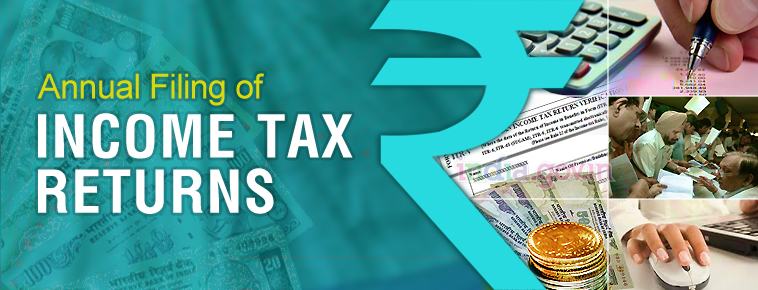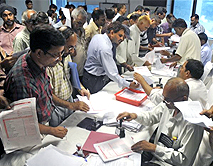
Income Tax in India was introduced by Sir James Wilson on 24 July 1860. It was a tax selectively imposed on the rich, royalty and Britishers, and hence was not liked by the powerful. In its first year, the exchequer collected a princely sum of Rs.30 lakh. The Act lapsed in 1865 and was re-introduced in a different form in 1867. Tax rates were based on a rough-and-ready assessment.

In the modern times, income tax is an annual tax on income. The Indian IncomeTax Act - External website that opens in a new window (Section 4) provides that in respect of the total income of the previous year of every person, income tax shall be charged for the corresponding assessment year at the rates laid down by the Finance Act for that assessment year. Section 14 of the Income Tax Act - External website that opens in a new window further provides that for the purpose of charge of income tax and computation of total income all income shall be classified under the following heads of income: salaries, income from house property, profits and gains of business or profession, capital gains, income from other sources.
The total income from all the above heads of income is calculated in accordance with the provisions of the Act as they stand on the first day of April of any assessment year. The Income Tax Department - External website that opens in a new window is responsible for all activities related to the taxation process.
The Income Tax Department - External website that opens in a new window is governed by the Central Board for Direct Taxes (CBDT) - External website that opens in a new window and is part of the Department of Revenue - External website that opens in a new window under the Ministry of Finance - External website that opens in a new window, Government of India.
Who is to Pay Income Tax?
The word income has a very broad and inclusive meaning. In case of a salaried person, all that is received from an employer in cash, kind or as a facility is considered as income. For a businessman, his net profits will constitute income. Income may also flow from investments in the form of Interest, Dividend, and Commission etc. Infact the Income Tax Act does not differentiate between legal and illegal income for the purpose of taxation. Under the Act, all incomes earned by people are classified into five different heads, such as: income from salary, income from house property, income from business or profession, income from capital gains and income from other sources.
Advertisements related to Income Tax - External website that opens in a new window
Helpline Numbers
For Income tax related queries, ASK : 1800 180 1961
For Rectification and Refund, CPC : 1800 425 2229
For e-Filing of Returns, e-Filing : xxxxxxxxxxxxxx
Tax Calculation and Payment
The Income Tax Department has developed an online Tax calculator - External website that opens in a new window. Individuals, HUF, Company, Firm, AOP, BOI, etc. can calculate their tax amount of the respective Assessment Year.
Taxpayers, deductors or collectors can pay taxes in cash/cheque at any designated bank branches - External website that opens in a new window by submitting the appropriate Challan - External website that opens in a new window. An online payment facility - External website that opens in a new window is also available.

As per Taxation Rules, it is mandatory for an earning individual/entity to file a return irrespective of the fact that tax has been deducted at source by his/her employer or not, and whether he/she is eligible for a refund or not.
Note: The CBDT has, vide notification dated 1-05-2013, made E-filing of Return compulsory for Assessment Year 2013-14 for persons having total assessable income exceeding Five lakh rupees.
The CBDT vide its earlier notifications had exempted salaried employees having total income upto Rs.5 lakhs including income from other sources upto Rs.10,000/- from the requirement of filing return of income for assessment year 2011-12 and 2012-13 respectively. The exemption was available only for the assessment year 2011-12 and 2012-13. The exemption was giving considering 'paper filing of returns' and their 'processing through manual entry' on system.
To file Income Tax Returns (ITRs), one needs to submit the ITRs belonging to the particular assessment year. The ITR forms to file income returns for AY 2013-14 are as follows:
Note:- All Forms are in PDF
Indian Individual Income tax Return
SAHAJ (ITR-1) - PDF file that opens in a new window
SAHAJ - PDF file that opens in a new window and SUGAM - PDF file that opens in a new window forms are coloured forms with standard features. Taxpayers can download - External website that opens in a new window the forms from the website and print using a colour printer on an A4 size white paper. To read the Print Specifications for SAHAJ and SUGAM click here - PDF file that opens in a new window.
Please read the instructions for SAHAJ - PDF file that opens in a new window before filling the form.
Individuals and HUFs not having income from Business or Profession
ITR 2 - PDF file that opens in a new window
Read instructions for ITR 2 - PDF file that opens in a new window
For Individuals/HUFs being partners in firms and not carrying out business or profession under any proprietorship
ITR 3 - PDF file that opens in a new window
Read instructions for ITR 3 - PDF file that opens in a new window
Sugam - Presumptive Business Income tax Return
SUGAM (ITR-4S) - PDF file that opens in a new window
To read the Print Specifications for SAHAJ and SUGAM click here - PDF file that opens in a new window. Please read the instructions for SUGAM before filling the form.
For individuals and HUFs having income from a proprietary business or profession
ITR 4 - PDF file that opens in a new window
Read instructions for ITR 4 - PDF file that opens in a new window
For firms, AOPs and BOIs
ITR 5 - PDF file that opens in a new window
Read instructions for ITR 5 - PDF file that opens in a new window
For Companies other than companies claiming exemption under section 11
ITR 6 - PDF file that opens in a new window
Read instructions for ITR 6 - PDF file that opens in a new window
For persons including companies required to furnish return under section 139(4A) or section 139(4B) or section 139(4C) or section 139(4D)
ITR 7 - PDF file that opens in a new window
Read instructions for ITR 7 - PDF file that opens in a new window
Acknowledgement for e-Return and non e-Return
Further instructions and forms for previous years can be found here - External website that opens in a new window.
E-Filing of Income Tax Returns
The E-Filing - External website that opens in a new window facility was introduced by the Income Tax Department for the first time during assessment year 2006-07. At present, it is mandatory for companies and firms requiring statutory audit under Section 44AB to e-file their Income Tax Returns. Also, the e-filing benefit has been extended to all assesses.
For registration in e-filling portal please click here - External website that opens in a new window.
The registered users can avail online services such as: submit Returns/Forms, view Form 26AS (Tax Credit), Outstanding Tax Demand, ITR-V Receipt Status, CPC Refund Status, Rectification Status, Jurisdiction of Accessment Officers, etc.

Tax Deduction at Source (TDS) is one of the modes of collection of taxes, by which a certain percentage of amounts are deducted from a person at the time of making/crediting certain specific nature of payment to the other person and the deducted amount is remitted to the Government account. It is similar to "pay as you earn" scheme also known as Withholding Tax in many other countries.
Every person responsible for making payment of nature covered by TDS provisions of Income Tax Act shall be responsible to deduct tax. However, in case of payments made under sec. 194A, 194C, 194H, 194I and 194J in respect of individual and HUF, only if the turnover or professional receipt exceeds sum of Rs.40 lakh or Rs.10 lakh respectively (the limits are Rs.60 Lakh or Rs.15 Lakh respectively w.e.f. 01.07.2010) in previous year, he is required to deduct tax at source.
Related links
- Online Tax Calculator - External website that opens in a new window
- Ministry of Finance - External website that opens in a new window
- Income Tax Department - External website that opens in a new window
- E-Filing Portal - External website that opens in a new window
- Download ITR forms - External website that opens in a new window
- Download Challans - External website that opens in a new window
- Frequently Asked Questions - External website that opens in a new window





 Individuals, Hindu Undivided Families, AOPs, BOIs
Individuals, Hindu Undivided Families, AOPs, BOIs

